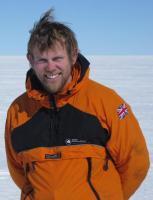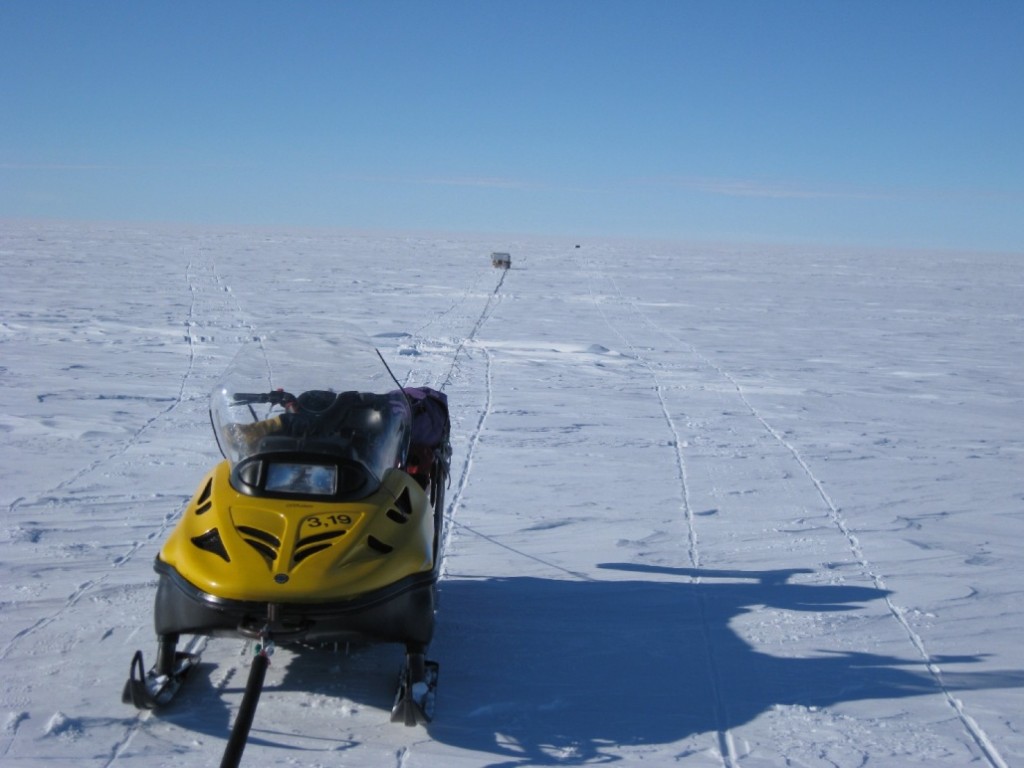What first got you interested in working in this part of West Antarctica?
Pine Island Glacier is a super-interesting area for Glaciologists and Oceanographers alike. You only need to look at satellite images to see that it’s one of the fastest changing areas on the planet. But there are a lot of things you can’t tell from space. That’s what is motivating us to go there and do some field geophysics work on the ground. I’m using radar instruments to find out how terrain under the ice affects its flow. We need that information to feed into computer models that are trying to predict the future of West Antarctica and how it will contribute to sea level rise.
You’ve been to Pine Island before, what was it like?
In the summer months when we’re there, the temperatures are usually between -10 and -20 degrees Celsius. In terms of the view, it’s like being at sea really, it looks the same in every direction – flat and white. Although it’s flat, it’s surprising how bumpy it can seem when you’re driving along because of the sastrugi (ripples on the surface of the snow formed by the wind) which can be up to a metre or so tall. The weather at Pine Island Glacier, though it’s known for being relatively harsh was actually better than in some other parts of Antarctica I’ve been to, but there was still a period of 8 days when we were stuck in our tent waiting for the white out to end.
What did you find out last time?
Last time we were using the same instrument we plan to use this time, a radar that can see through the ice to the bed underneath. We pulled the radar along behind snowmobiles (see photo below). Last time we drove lots of really long lines with the radar, 100km at a time. You could call it a reconnaissance trip because at the time we had very limited knowledge of the bed and we were measuring some quite basic information about the shape and nature of the subglacial terrain.
And what are you trying to find out this time?
Now we know a bit more about what is under the ice because as well as our previous work, there have been some airborne surveys of the area so this time our aims are a bit different. We are targeting smaller areas and looking in a lot more detail. We’ve chosen some 10kmx10km grids and we’ll be hoping to get a real impression of the 3D subglacial topography in these areas and how it has evolved. It’s amazing how really small changes in the glacier bed can have quite a big influence in the way the ice flows over time. Actually it’s quite a complicated picture in places which makes understanding the ice flow a real challenge but that’s what we need to do if we want to know what is likely to happen in the future.
You were last working on Pine Island Glacier 6 years ago. If you returned to the same patch of ice you camped on last time, roughly how far will it have moved in those 6 years?
One of our earlier campsites will have moved about 10km downstream! Parts of Pine Island Glacier are moving at up to 2km a year which makes Pine Island Glacier one of the fastest moving glaciers in the world. It’s currently contributing more ice to sea level rise than any other individual glacier. That really drives home just how important it is for us to understand the changes that are taking place.
Having spent quite a bit of time camping in Antarctica already, what personal luxuries will you be taking to make your life a little easier?
I’ll be spending quite a while carefully selecting the music to load on my iPod. It’s pretty important as otherwise, despite the fact this it’s a special experience being out in the Antarctic wilds it can still get a bit monotonous driving many hours very slowly in a straight line acros the flat landscape for hours on end!
What are you least looking forward to about your upcoming trip?
Without a doubt the hardest thing for me will be being away from my family. It was always hard before but this time it is enhanced by the arrival last year of our baby daughter Rachel. It will be the first time I’ve been so far away from her and so that will be really hard.
Tell me a story about working in Antarctica on one of your previous trips…
On my last Antarctic trip I spent about 2 months camping on Ferrigno Ice Stream, a little north of Pine Island Glacier. For most of the trip the weather was pretty desperate and as a result we were behind schedule with work. Trying to play catch-up one day when the weather was still not that great we were trying to drive along with the radar in tow when the cloud starting rolling in again and conditions deteriorated until it was almost a white out. It would have been fine on a flat surface but there were some huge sastrugi. Chris, my guide, was driving ahead of me when he hit a giant sastrugi and his snowmobile rolled over. A few seconds later the same thing happened to me! The bumps were complete invisible in the whiteout , and it was all very surreal. We managed to right the snowmobiles but we had to give up work for that day and head straight back to camp I have never spent so many days in a tent as on that field season!
To travel around in Antarctica we use two snowmobiles tied together with sledges behind them carrying all our living and science equipment. Chris, my field assistant on that trip, has been working in Antarctica since the 80s and, before the Ferrigno trip, had only tipped his sledge over about twice ever. On that trip our sledges tipped about 20 times, that’s how bad the conditions were.
What motivates you to work in such tough conditions?
Although it can be tough, it’s an amazing feeling to be somewhere so isolated and so beautiful so just being there motivates me. One of the reasons I chose glaciology in the first place was to spend time in beautiful mountainous places. Actually, I never thought I’d end up working somewhere like West Antarctica where the mountains are buried underneath so much ice that you can’t see them!
The science mission motivates me too. Antarctica’s a hard place to get to and you only have limited time there so when I’ve got a science mission in mind it helps motivates me to go out and work in conditions like the ones I’ve described.


